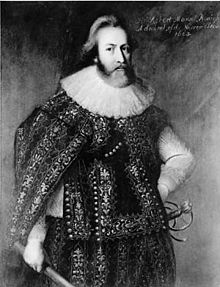|
Mansel family
           The Mansel family (/mænsəl/, MAN-səl), also known throughout history as Mansell and Maunsell (Old French: Mansel, lit. 'someone from Le Mans, France'), is a British noble family. HistoryOriginThe Mansels came to England during the Norman Conquest and were established in Wales by the time of Henry I. Sir Robert Maunsel (born c. 1150) was a Templar under Baron Gilbert de Lacy in Palestine during the reign of Henry II. His father, Walter, a deacon, was Napkin Bearer to the King. Sir John Maunsell, grandson of Sir Robert, was lord Chancellor to Henry III and England's first secretary of state.[1] He is listed in most Mansel genealogies as ancestor of the Lords Mansell of Margam, the Carmarthenshire Mansells, and the Maunsells of Ireland and Thorpe Malsor.[2] Baronets of Muddlescombe and TrimsaranThe Mansel Baronetcy of Muddlescombe, in the County of Carmarthen, was created in the Baronetage of England on 14 January 1622 for Sir Francis Mansel, younger brother of Sir Thomas Mansell, 1st Baronet of Margam.[3] Sir William Mansel, 9th Baronet sat as Member of Parliament for Carmarthenshire.[4] There was great confusion over the succession after the death of Sir John Bell William Mansel, 11th Baronet in 1883. The rightful heir was believed to be Edward Berkeley Philipps (later Mansel), son of Courtenay Philipps, son of Richard Mansel, younger brother of the tenth Baronet. However, it was widely believed that Courtenay Philipps's first marriage was invalid. The title was therefore assumed by Edward Berkeley Philipps's brother Richard Philipps (later Mansel) as the twelfth Baronet. On his death in 1892 the title was assumed by his son Courtenay Cecil Mansel, the thirteenth Baronet. However, in 1903 the latter discovered evidence that his grandfather's first marriage was indeed valid and relinquished the use of the title in favour of his uncle Edward Berkeley Philipps (later Mansel), who became the twelfth Baronet. When he died childless in 1908 the title was resumed by his nephew Courtenay Cecil Mansel, the thirteenth Baronet.[5] Sir Courtenay Cecil Mansel later represented Penryn and Falmouth in the House of Commons.[5] The Mansel Baronetcy of Muddlescombe is the only extant Mansel baronetcy as of the present day, with Sir Philip Mansel, 15th baronet (born 1943) having succeeded to the baronetcy on the death of his father, Sir John Philip Ferdinand Mansel, 14th baronet in 1947. The Mansel Baronetcy of Trimsaran, in the County of Carmarthen, was created in the Baronetage of England on 22 February 1697 for Sir Edward Mansel, great-grandson of Sir Francis Mansel, 1st Baronet of Muddlescombe.[6] The title became extinct on the death of the fourth baronet Sir Edward Joseph Shewen Mansel in 1798. Barons Mansel of MargamThe title of Baron Mansel, of Margam in the County of Glamorgan, was created on 1 January 1712 for Sir Thomas Mansel, 5th Baronet, previously Member of Parliament for Cardiff and Glamorganshire. His great-grandfather Sir Thomas Mansell, 1st Baronet had been created a Baronet, of Margam in the County of Glamorgan, in the Baronetage of England on 22 May 1611. He held the office of High Sheriff of Glamorgan in 1593 and was twice elected as Member of Parliament for Glamorgan in 1597 and 1605.[7] Sir Edward Mansel, 4th Baronet was also elected to the House of Commons representing Glamorgan. Thomas Mansel, 1st Baron Mansel was succeeded by his grandson Thomas Mansel, son of Hon. Robert Mansel.[8] Thomas Mansel, 2nd Baron Mansel died unmarried on 29 January 1744 and the title passed to Christopher Mansel, son of the first Baron, who also died unmarried.[9] Bussy Mansel, third son of the first Baron, thus inherited the title.[9] Bussy Mansel, 4th Baron Mansel sat as Member of Parliament for Cardiff and Glamorganshire. He married Lady Elizabeth Hervey, the daughter of John Hervey, 1st Earl of Bristol[10] and died without issue on 29 November 1750. On the death of the 4th baron, the barony and baronetcy became extinct and the Margam estates passed to his daughter Louisa, who married George Venables-Vernon, subsequently 2nd Baron Vernon. Following her death without issue in 1786, it passed to her aunt Mary Mansell, who had married John Ivory Talbot of Lacock Abbey, Wiltshire.[7] However, other parts of the estates (subsequently known as the Briton Ferry estate) passed to her uncle Thomas Villiers, 1st Earl of Clarendon then to William Henry Augustus Villiers (who took the surname Mansell to inherit this estate). On his death without issue, it passed to his elder brother's son George Child Villiers, 5th Earl of Jersey.[11] Maunsells of Thorpe MalsorIn 1622, John Maunsell, Esq., of Chicheley, Buckinghamshire, a barrister, purchased from Lord Holland the rectory, manor, and estate of Thorpe Malsor, about two miles west from Kettering, Northamptonshire, in Rothwell Hundred.[12][13] From that time, the main stock of the family continued to reside at Thorpe Malsor in affluence and distinction.[14][15] John Maunsell died on 19 October 1625.[13] He had two sons with Katherine Ward, daughter of Sir Richard Ward of Hurst.[13] Pedigree
References
Sources
|
||||||||||||||
Portal di Ensiklopedia Dunia
